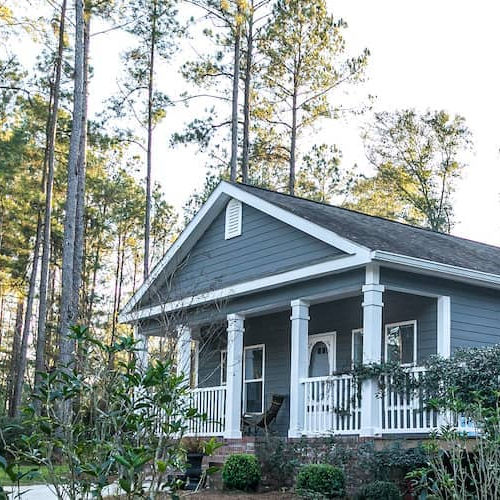Single-wide homes vs. double-wide homes: Which is right for you?
Contributed by Karen Idelson
Dec 16, 2025
•6-minute read

Buying a home on a budget can be challenging. For many buyers, especially first-timers, manufactured homes offer a more affordable path to homeownership. Built in a factory and transported to a home site, these homes come in two main types: single-wide and double-wide. Compared with site-built homes, which are constructed directly on a foundation, manufactured homes can be faster and less expensive to purchase and install.
Single-wide homes are smaller, easier to move, and more affordable. Double-wide homes provide more space, flexibility, and often stronger resale potential. Understanding the key differences between the two can help you decide which fits your lifestyle, budget, and long-term goals.
What’s a single-wide manufactured home?
Before 1976, manufactured homes were called mobile homes. That changed when the National Manufactured Housing Construction and Safety Standards Act was passed in 1974, and the federal building code administered by the U.S. Department of Housing and Urban Development (HUD) took effect two years later. Modern single-wide manufactured homes now meet these HUD standards for safety, durability, and energy efficiency.
A single-wide manufactured home has a simple, streamlined layout that’s transported in one piece and set on a permanent or semi-permanent foundation. Its smaller footprint keeps costs down and upkeep manageable. This makes it a practical choice for anyone who values flexibility and affordability.
What’s a double-wide manufactured home?
Buyers often ask, “What is a double-wide home?” In short, it’s a manufactured home built in two sections and joined on-site to create a wider floor plan. The double-wide home originated in 1967 when two single-wide sections were combined on-site to create a larger floor plan. Modern double-wides are more advanced. They feature spacious, open layouts, multiple bedrooms and bathrooms, and interior designs that often resemble site-built homes.
Modern double-wide manufactured homes offer the benefits of a larger footprint and increased comfort while still being relatively affordable compared to traditional homes. For buyers seeking more room for family life, guests, or hobbies, a double-wide can be an appealing middle ground between affordability and space.
What’s the difference between single-wide and double-wide mobile homes?
The primary difference lies in construction and size. Single-wide homes are built in one section, transported as a single unit, and installed on-site. Double-wide homes are built in two sections and joined together at the final location.
As a result, double-wide homes are typically twice the size of single-wides and are situated on larger lots. The trade-off is that double-wides cost more, take longer to install, and are harder to relocate.
Single-wide homes vs. double-wide homes: Key characteristics
Comparing features side by side can clarify which type of home fits your needs. Figures may vary depending on the manufacturer, design, and region; however, the chart below provides a general overview.
According to the latest data from the U.S. Census Bureau’s Manufactured Housing Survey, the average sales price of new manufactured homes was about $124,800 in April 2025. Prices for single-section homes inched up, while double-section homes dipped a bit, reflecting stable costs overall and continued affordability compared to site-built houses.
| Single-wide homes | Double-wide homes | |
|---|---|---|
| Square footage | 500 – 1,300 square feet | 1,000 – 2,300 square feet |
| Dimensions |
12 – 18 feet wide 40 – 80 feet long |
20 – 36 feet wide 32 – 90 feet long |
| Floor plan |
Fewer room layout options Narrow and long |
More spacious floor plan Wider and shorter |
| Average cost (April 2025) | $88,500 | $152,900 |
Size of manufactured homes
Manufactured home size varies by type. A single-wide usually ranges from about 500 to 1,300 square feet, with widths of 12 to 18 feet and lengths of 40 to 80 feet. Double-wide homes offer roughly twice that space, averaging 1,000 to 2,300 square feet or more, with widths between 20 and 36 feet and lengths from 32 to 90 feet.
Because double-wides have larger footprints, they need more lot space — an important factor to consider when budgeting for land or placement costs. For context, the average square footage of a house in the U.S. varies by region, which can also influence how spacious a manufactured home feels in comparison.
Floor plans and upgrades
Single-wide homes have a smaller footprint, so their layouts are usually simpler and best suited for individuals or couples without children. Double-wide models offer more variety in design. They can include added space for a second bedroom, a dining room or a larger kitchen. This creates a layout that functions much like a traditional site-built home.
While manufactured homes can be harder to personalize than traditional builds, renovations and additions are possible, especially with double-wides. Common upgrades include adding a front porch, deck, or extra bedroom or bathroom. These improvements can boost comfort and may increase resale potential over time.
Cost of manufactured homes
Single-wide homes generally cost less, averaging about $88,500 nationwide. Double-wides, which offer more square footage and design flexibility, average around $152,900. Setup fees for single-wide typically start at $1,500 and double-wide set up can start around $3,000.
The total price can shift based on where the home is installed, the type of foundation, transportation distance, and the features you choose. Adding details such as a front porch, upgraded finishes, or energy-efficient systems will raise the overall cost but can also improve comfort and resale potential.
Ongoing expenses like utilities and maintenance depend on the home’s size. Larger homes tend to use more energy, but efficient HVAC systems and improved insulation can help keep costs in check. It’s also important to account for permits, land preparation, foundation work, and utility connections when estimating your full budget.
Transportation of single-wide and double-wide homes
Both single-wide and double-wide homes are mobile and can be transported to new locations. However, before either can be placed on a property, the site must be properly prepared. That means clearing and leveling the land, ensuring it’s accessible for delivery, and installing a foundation like as a concrete slab or crawl space.
Local weather patterns and building codes can affect which foundation types are allowed. Areas prone to flooding may have stricter elevation requirements.
Single-wide homes are easier to move because they are a single, continuous section. Double-wide homes need to be separated into two parts for transport, which requires more time, equipment, and sometimes escort vehicles for handling wider loads. Logistical differences like this can influence your decision if mobility is important to you.
Resale value
When comparing resale potential, single-wide homes usually lose more value over time, often selling for 30% to 50% less than double-wides. Because double-wide homes look and live more like traditional houses, they tend to attract more buyers and hold their value longer.
Financing and insurance play a role in long-term affordability. Some lenders have stricter requirements for manufactured homes. Insurance premiums vary by size, foundation, and location. According to Realtor.com, the average cost of mobile home insurance typically ranges from $700 to $1,500 a year but can reach about $1,800 in high-risk states like Florida. Understanding how your home’s assessed value compares to its market value can help you plan for resale or refinancing.
Single-wide mobile homes vs. double-wide mobile homes: Pros and cons
Each type of manufactured home comes with trade-offs. A single-wide may appeal for its lower cost and flexibility, while a double-wide offers more space and features. Thinking through those differences — the pros and cons of manufactured homes — can help you decide which option fits your budget and lifestyle best.
Single-wide home pros and cons
| Single-wide home pros | Single-wide home cons |
|---|---|
| Less expensive | Smaller |
| Easier to transport | Lower resale value, therefore harder to resell |
| Low maintenance costs | Limited design and alteration potential |
| Quick setup and construction | |
| Lower taxes |
Double-wide home pros and cons
| Double-wide home pros | Double-wide home cons |
|---|---|
| Larger | More expensive |
| Spacious and flexible floor plan | Longer construction time |
| Easier to resell | Higher taxes |
The future of single-wide and double-wide homes
Single-wide and double-wide homes still differ from site-built houses, but the gap in quality and design may narrow over time. Builders are already experimenting with new modular construction technology that improves energy efficiency, reduces material usage, and streamlines the assembly process of these homes. Over time, the growing popularity in modular homes could mean more choices in layout, finishes, and customization.
These changes can make manufactured homes feel more like traditional houses. The result is that buyers may find that manufactured homes offer a better balance between quality, cost, and sustainability than ever before.The bottom line: Do you value space or price more?
Single-wide and double-wide homes both make homeownership more accessible. A single-wide offers a lower price and easier mobility, while a double-wide provides added space and stronger resale potential.
When comparing single-wide vs. double-wide homes, most buyers focus on size, cost, and floor plan flexibility. Your choice ultimately depends on what matters most to you. If a manufactured home sounds like the right fit, explore loan options with Rocket Mortgage to find financing that supports your goals and budget.

Sam Hawrylack
Samantha is a full-time personal finance and real estate writer with 5 years of experience. She has a Bachelor of Science in Finance and an MBA from West Chester University of Pennsylvania. She writes for publications like Rocket Mortgage, Bigger Pockets, Quicken Loans, Angi, Well Kept Wallet, Crediful, Clever Girl Finance, AllCards, InvestingAnswers, and many more.
Related resources
6-minute read
Modular vs. manufactured homes: What's the difference?
Modular and manufactured homes are both factory-built, but they have some key differences. Uncover the distinctions between modular and manufactured homes.
Read more
10-minute read
The basics behind financing a mobile or manufactured home
Manufactured or mobile homes may be the key to affordable homeownership. Learn how you can finance one under the favorable terms of conventional loans.
Read more
6-minute read
Everything you should know about financing a modular home
A modular home is a type of prefabricated, manufactured home. Here’s what you should know if you’re considering financing a modular home.
Read more